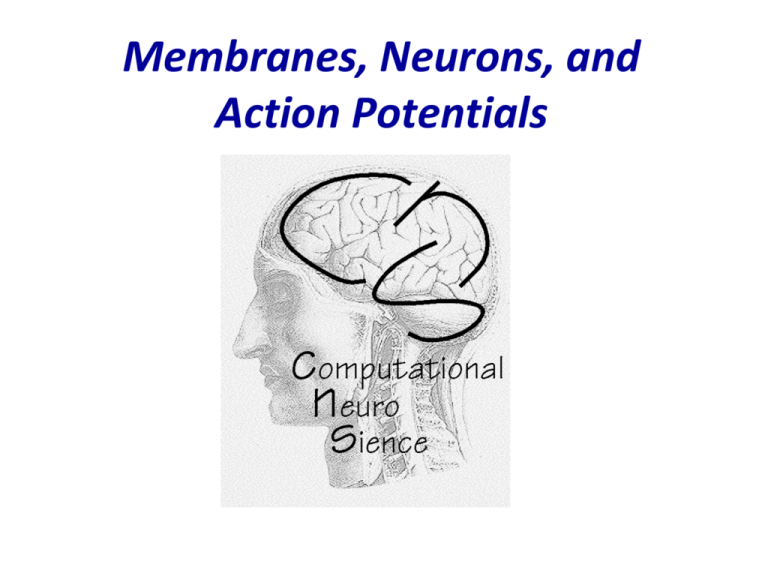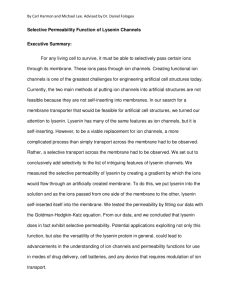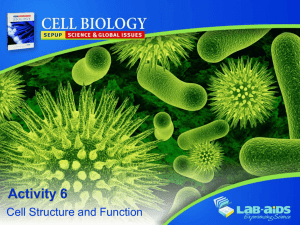nc 02 Neurons
advertisement

Membranes, Neurons, and Action Potentials Some Organizational Stuff... For credit points: At the end of the semester you will have a written test. 28.07.2014: 8.15-8.45; Waldweg 26, Altbau – 1.201 Repeated test: 15.09.2014: 8.15-8.45; Waldweg 26, Altbau – 1.201 2-3 times during the semester you will get some exercises. They are voluntary, but useful for everybody. Lecture for basics of (experimental) neuroscience: Neuro- und Verhaltensbiologie – Prof. Fiala; Wed. 10-12; Mikrobiologie; MN06 Slides can be downloaded from http://www.physik3.gwdg.de/cns/... The Interdisciplinary Nature of Computational Neuroscience The Applications Artificial Neural Networks (Problem Solving) Chip Design new approaches questions Computer Science Non-Linear Dynamics Special Robotics Medicine Psychology Computational Neuroscience tools Social Networks answers predictions ElectroBiophysiology chemistry The World (Problems) Marketing The Methods Information Theory Computer Vision Psychophysics facts CNS Neuroanatomy Neurophysiology The Brain (Substrate) Systems Areas Local Nets Neurons Synapses Mathematics Physics Chemistry Biology The Sciences (Fundament) Molecules Levels of Information Processing in the Nervous System 1m CNS 10cm Sub-Systems 1cm Areas / „Maps“ 1mm Local Networks 100mm Neurons 1mm Synapses 0.01mm Molecules Structure of a Neuron: At the dendrite the incoming signals arrive (incoming currents) At the soma current are finally integrated. At the axon hillock action potential are generated if the potential crosses the membrane threshold The axon transmits (transports) the action potential to distant sites CNS At the synapses are the outgoing signals transmitted onto the dendrites of the target neurons Systems Areas Local Nets Neurons Synapses Molecules The Underlying Structure of Neurons: The Membrane CNS Systems Areas Local Nets Neurons • Potassium (K+) • Sodium (Na+) • Chloride (Cl-) • Calcium (Ca++) • Protein Anions (A-) Synapses Molecules Selective Ion Channels How complicated are Ion Channels? For instance, a sodium (Na+) channel looks (schematically!) something like this: How complicated are Ion Channels? For instance, a sodium (Na+) channel looks (schematically!) something like this: Different Types of Ion Channels membrane + out - in always open opening depends on membrane potential transports ions against concentration gradient What is the influence of ion channels on the neuron’s dynamics? At synapses: neurotransmitter + out fast slow opening depends on neurotransmitters - in The Influence of Passive Channels The Influence of Passive Channels + Outside of cell Although the inside of the cell is negatively charged, amounts of positive potassium stays outside. But why? Inside of cell - Potassium diffuses via the ion channels to the outside → Equilibrium between Force of Diffusion and Electrostatic Force What are the effects of this equilibrium? What are the effects of the equlibrium at a membrane? Difficult question Let’s make a detour and think about our atmosphere (perhaps this helps) Our Atmosphere and the Distribution of Particles 𝑗𝑠𝑖𝑛𝑘 = 𝑗𝑑𝑖𝑓𝑓 Equilibrium: Sink current 𝑗𝑠𝑖𝑛𝑘 air particles Earth’s surface 𝑘: Boltzmann’s constant 𝑇: Temperature Height ℎ Diffusion current 𝑗𝑑𝑖𝑓𝑓 𝑑𝑛(ℎ) μ𝑚𝑔 ∙ 𝑛 ℎ = −𝐷 ∙ 𝑑ℎ ℎ 𝑛 μ𝑚𝑔 1 𝑑𝑛 − 𝑛 𝐷 𝑑ℎ = ℎ=0 ? Number of particles 𝑛(ℎ) Einstein relation: 𝐷 = μ𝑘𝑇 𝒏(𝒉): number of particles in height 𝒉 μ: mobility 𝑚: mass 𝑔: gravity constant 𝐷: diffusion constant 𝑛(ℎ=0) − μ𝑚𝑔ℎ 𝑛 = ln 𝐷 𝑛0 𝑛 ℎ = 𝑛0 𝑒𝑥𝑝 − 𝑛 ℎ = 𝑛0 𝑒𝑥𝑝 − 𝑛0 ≝ 𝑛 ℎ = 0 μ𝑚𝑔ℎ 𝐷 𝑚𝑔ℎ 𝑘𝑇 𝐸𝑔𝑟𝑎𝑣 𝑛 ℎ = 𝑛0 𝑒𝑥𝑝 − 𝑘𝑇 Gravitational energy 𝐸𝑔𝑟𝑎𝑣 Barometric formula Our Atmosphere and the Distribution of Particles Barometric formula 𝑛 ℎ = 𝑛0 𝑒𝑥𝑝 − Sink current 𝑗𝑠𝑖𝑛𝑘 Height ℎ Diffusion current 𝑗𝑑𝑖𝑓𝑓 𝑛1 ≝ 𝑛 ℎ1 𝑛(ℎ): number of particles in height ℎ 𝐸𝑔𝑟𝑎𝑣 𝑘𝑇 𝑘: Boltzmann’s constant 𝑇: Temperature 𝐸1 = 𝑛0 𝑒𝑥𝑝 − 𝑘𝑇 ℎ1 ℎ2 air particles Earth’s surface Number of particles 𝑛(ℎ) 𝑛2 ≝ 𝑛 ℎ2 = 𝑛0 𝑒𝑥𝑝 − 𝐸2 𝑘𝑇 𝐸1 𝑛1 𝑘𝑇 = 𝑒𝑥𝑝 − 𝐸1 − 𝐸2 = 𝑛2 𝑛 𝑒𝑥𝑝 − 𝐸2 𝑘𝑇 0 𝑘𝑇 𝑛0 𝑒𝑥𝑝 − 𝑛1 Δ𝐸 = 𝑒𝑥𝑝 − 𝑛2 𝑘𝑇 Boltzmann distribution Our Atmosphere and the Distribution of Particles = The Membrane with Channels and Ions Barometric formula 𝑛 ℎ = 𝑛0 𝑒𝑥𝑝 − Sink current 𝑗𝑠𝑖𝑛𝑘 Height ℎ Diffusion current 𝑗𝑑𝑖𝑓𝑓 channel membrane potassium ions air particles Earth’s surface 𝑛1 ℎ1 ℎ2 𝑛2 Number of particles 𝑛(ℎ) 𝑛1 ≝ 𝑛 ℎ1 𝑛(ℎ): number of particles in height ℎ 𝐸𝑔𝑟𝑎𝑣 𝑘𝑇 𝑘: Boltzmann’s constant 𝑇: Temperature 𝐸1 = 𝑛0 𝑒𝑥𝑝 − 𝑘𝑇 𝑛2 ≝ 𝑛 ℎ2 = 𝑛0 𝑒𝑥𝑝 − 𝐸2 𝑘𝑇 𝐸1 𝑛1 𝑘𝑇 = 𝑒𝑥𝑝 − 𝐸1 − 𝐸2 = 𝑛2 𝑛 𝑒𝑥𝑝 − 𝐸2 𝑘𝑇 0 𝑘𝑇 𝑛0 𝑒𝑥𝑝 − 𝑛1 Δ𝐸 = 𝑒𝑥𝑝 − 𝑛2 𝑘𝑇 Boltzmann distribution Our Atmosphere and the Distribution of Particles = The Membrane with Channels and Ions Electric current 𝑘: Boltzmann’s constant 𝑇: Temperature Diffusion current 𝑗𝑑𝑖𝑓𝑓 Sink current 𝑗𝑠𝑖𝑛𝑘 channel 𝑛1 𝑐𝑜𝑢𝑡 𝑛2 𝑐𝑖𝑛 membrane potassium ions Now, we take as energy difference Δ𝐸 the difference in electric energy Δ𝐸𝑒𝑙𝑒𝑐 = 𝑧𝑒𝑉. 𝑐𝑖𝑛 [𝐾 + ]𝑖𝑛 𝑧𝑒𝑉 = = 𝑒𝑥𝑝 − 𝑐𝑜𝑢𝑡 𝑘𝑇 [𝐾 + ]𝑜𝑢𝑡 𝑛1 Δ𝐸 = 𝑒𝑥𝑝 − 𝑛2 𝑘𝑇 𝑉: potential 𝑧: moles of charges 𝑒: elementary charge Boltzmann distribution The Membrane with Channels and Ions: Nernst Equation + 𝑐𝑖𝑛 [𝐾 ]𝑖𝑛 𝑧𝑒𝑉 = = 𝑒𝑥𝑝 − 𝑐𝑜𝑢𝑡 𝑘𝑇 [𝐾 + ]𝑜𝑢𝑡 Force of Diffusion Electrostatic Force 𝑉=− channel 𝑘𝑇 𝑐𝑖𝑛 𝑙𝑛 𝑧𝑒 𝑐𝑜𝑢𝑡 𝑐𝑜𝑢𝑡 membrane potassium ions 𝑘: Boltzmann’s constant 𝑇: Temperature 𝑉: potential 𝑧: moles of charges 𝑒: elementary charge 𝑐𝑖𝑛 𝑅𝑇 𝑐𝑖𝑛 𝑉=− 𝑙𝑛 𝑧𝐹 𝑐𝑜𝑢𝑡 Nernst Equation 𝑘 𝑅 = 𝑒 𝐹 𝑅: universal gas constant 𝐹: Faraday constant For 𝑇 = 310𝐾 (36.85 °𝐶) 𝑉=− 26.7𝑚𝑉 𝑐𝑖𝑛 𝑙𝑔 𝑧 𝑐𝑜𝑢𝑡 A membrane with open channels (semipermeable) induces an electric potential: the membrane potential The Influence of Passive Channels + Outside of cell Although the inside of the cell is negatively charged, amounts of positive potassium stays outside. But why? Inside of cell - Potassium diffuses via the ion channels to the outside → Equilibrium between Force of Diffusion and Electrostatic Force What are the effects of this equilibrium? A membrane with open channels (semipermeable) induces an electric potential: the membrane potential Different Types of Ion Channels membrane + out - in always open opening depends on membrane potential transports ions against concentration gradient membrane potential At synapses: neurotransmitter + out fast slow opening depends on neurotransmitters - in The Role of Ion Pumps in General For instance the sodium(Na+)-potassium(K+) pump: Nernst Equation 𝑅𝑇 𝑐𝑖𝑛 𝑉=− 𝑙𝑛 𝑧𝐹 𝑐𝑜𝑢𝑡 in general Goldman Equation 𝑅𝑇 𝑉= 𝑙𝑛 𝐹 𝑁 + 𝐾 [𝐴𝑗− ]𝑖𝑛 𝑖 𝑃𝑀𝑖+ [𝑀𝑖 ]𝑜𝑢𝑡 + 𝑗 𝑃𝐴− 𝑗 + 𝑁 𝐾 − [𝐴 ]𝑜𝑢𝑡 𝑖 𝑃𝑀𝑖+ [𝑀𝑖 ]𝑖𝑛 + 𝑗 𝑃𝐴− 𝑗 𝑗 𝑃: permeability The Role of Ion Pumps in Neurons K+ Na+ Herleitung Goldman Equation 𝑅𝑇 𝑉= 𝑙𝑛 𝐹 𝑁 + 𝐾 [𝐴𝑗− ]𝑖𝑛 𝑖 𝑃𝑀𝑖+ [𝑀𝑖 ]𝑜𝑢𝑡 + 𝑗 𝑃𝐴− 𝑗 + 𝑁 𝐾 − [𝐴 ]𝑜𝑢𝑡 𝑖 𝑃𝑀𝑖+ [𝑀𝑖 ]𝑖𝑛 + 𝑗 𝑃𝐴− 𝑗 𝑗 simulation Goldman-Hodgkin-Katz Equation neuron 𝑅𝑇 𝑃𝐾+ [𝐾 + ]𝑜𝑢𝑡 +𝑃𝑁𝑎+ [𝑁𝑎+ ]𝑜𝑢𝑡 +𝑃𝐶𝑙− [𝐶𝑙 − ]𝑖𝑛 𝑉= 𝑙𝑛 𝐹 𝑃𝐾+ [𝐾 + ]𝑖𝑛 +𝑃𝑁𝑎+ [𝑁𝑎+ ]𝑖𝑛 +𝑃𝐶𝑙− [𝐶𝑙− ]𝑜𝑢𝑡 Different Types of Ion Channels membrane + out - in always open opening depends on membrane potential transports ions against concentration gradient At synapses: neurotransmitter + out fast slow opening depends on neurotransmitters - in Schematic Diagram of a Synapse: Receptor ≈ Channel Transmitter Vesicle CNS Systems Dendrite Areas Local Nets Neurons Synapses Molecules What happens at a chemical synapse during signal transmission: Pre-synaptic action potential The pre-synaptic action potential depolarises the axon terminals and Ca2+-channels open. Ca2+ enters the pre-synaptic cell by which the transmitter vesicles are forced to open and release the transmitter. Concentration of transmitter in the synaptic cleft Post-synaptic action potential Thereby the concentration of transmitter increases in the synaptic cleft and transmitter diffuses to the postsynaptic membrane. Transmitter sensitive channels at the postsyaptic membrane open. Na+ and Ca2+ enter, K+ leaves the cell. An excitatory postsynaptic current (EPSC) is thereby generated which leads to an excitatory postsynaptic potential (EPSP). The Effect of Synaptic Inputs on the Membrane Potential Goldman-Hodgkin-Katz Equation: 𝑅𝑇 𝑃𝐾+ [𝐾 + ]𝑜𝑢𝑡 +𝑃𝑁𝑎+ [𝑁𝑎+ ]𝑜𝑢𝑡 +𝑃𝐶𝑙− [𝐶𝑙 − ]𝑖𝑛 𝑉= 𝑙𝑛 𝐹 𝑃𝐾+ [𝐾 + ]𝑖𝑛 +𝑃𝑁𝑎+ [𝑁𝑎+ ]𝑖𝑛 +𝑃𝐶𝑙− [𝐶𝑙− ]𝑜𝑢𝑡 Task for everybody: Discuss with your neighbors possible problems using the GoldmanHodgkin-Katz Equation to describe the membrane potential influenced by synaptic inputs! • Permeability depends on Voltage The Effect of Synaptic Inputs on the Membrane Potential Goldman-Hodgkin-Katz Equation: 𝑅𝑇 𝑃𝐾+ [𝐾 + ]𝑜𝑢𝑡 +𝑃𝑁𝑎+ [𝑁𝑎+ ]𝑜𝑢𝑡 +𝑃𝐶𝑙− [𝐶𝑙 − ]𝑖𝑛 𝑉= 𝑙𝑛 𝐹 𝑃𝐾+ [𝐾 + ]𝑖𝑛 +𝑃𝑁𝑎+ [𝑁𝑎+ ]𝑖𝑛 +𝑃𝐶𝑙− [𝐶𝑙− ]𝑜𝑢𝑡 At synapses, the ion channels open and close dependent on time-dependent signals. This means that the permeabilities change over time: 𝑃𝑥 → 𝑃𝑥 (𝑡). really complicated… The Goldman-Hodgkin-Katz Equation holds only for the equilibrium. Problem? The Effect of Synaptic Inputs on the Membrane Potential: the problem of equilibrium Membrane Potential 𝑅𝑇 𝑃𝐾+ [𝐾 + ]𝑜𝑢𝑡 +𝑃𝑁𝑎+ [𝑁𝑎+ ]𝑜𝑢𝑡 +𝑃𝐶𝑙− [𝐶𝑙 − ]𝑖𝑛 𝑉= 𝑙𝑛 𝐹 𝑃𝐾+ [𝐾 + ]𝑖𝑛 +𝑃𝑁𝑎+ [𝑁𝑎+ ]𝑖𝑛 +𝑃𝐶𝑙− [𝐶𝑙− ]𝑜𝑢𝑡 Transient dynamic Equilibrium Transient dynamic Equilibrium Equilibrium 𝑽=? 𝑽=? Synaptic Input time 𝑽=? time For fast changing inputs the GoldmannHodkin-Katz Equation is not valid. The Effect of Synaptic Inputs on the Membrane Potential Goldman-Hodgkin-Katz Equation: 𝑅𝑇 𝑃𝐾+ [𝐾 + ]𝑜𝑢𝑡 +𝑃𝑁𝑎+ [𝑁𝑎+ ]𝑜𝑢𝑡 +𝑃𝐶𝑙− [𝐶𝑙 − ]𝑖𝑛 𝑉= 𝑙𝑛 𝐹 𝑃𝐾+ [𝐾 + ]𝑖𝑛 +𝑃𝑁𝑎+ [𝑁𝑎+ ]𝑖𝑛 +𝑃𝐶𝑙− [𝐶𝑙− ]𝑜𝑢𝑡 At synapses, the ion channels open and close dependent on time-dependent signals. This means that the permeabilities change over time: 𝑃𝑥 → 𝑃𝑥 (𝑡). really complicated… The Goldman-Hodgkin-Katz Equation holds only for the equilibrium. Problem? YES!!! Different Types of Ion Channels membrane + out - in always open opening depends on membrane potential transports ions against concentration gradient At synapses: The chemical model of a membrane becomes neurotransmitter too complicated + out fast slow - in We need another model opening depends on neurotransmitters Different Types of Ion Channels: Second Model membrane + out - in always open opening depends on membrane potential transports ions against concentration gradient At synapses: neurotransmitter + out fast slow opening depends on neurotransmitters - in The Influence of Ion Channels membrane without channels + out - in acts like a capacitor + Kirchhoff’s law: 𝐶= 𝑄 𝑉 𝑑 𝑑 ∙ 𝐶 ∙ 𝑉 = 𝑄∙ 𝑑𝑡 𝑑𝑡 const. 𝑑𝑄 𝐶 ∙ 𝑑𝑉 𝑑𝑡 = 𝑑𝑡 𝐶 ∙ 𝑑𝑉 𝑑𝑡 = −𝐼 𝐶: capacity 𝑄: charge 𝑉: potential 𝐼: current The Influence of Ion Channels membrane without channels leakage channels + out - in acts like a capacitor + Kirchhoff’s law: acts like a resistance + 𝐶= 𝑄 𝑉 𝑑 𝑑 ∙ 𝐶 ∙ 𝑉 = 𝑄∙ 𝑑𝑡 𝑑𝑡 const. 𝑑𝑄 𝐶 ∙ 𝑑𝑉 𝑑𝑡 = 𝑑𝑡 𝐶 ∙ 𝑑𝑉 𝑑𝑡 = −𝐼 Ohm’s law: 𝑉 = 𝑅 ∙ 𝐼 with 𝑅 = 1 𝑔 𝐼 =𝑔∙𝑉 𝑔: conductance 𝑅: resistance 𝐶: capacity 𝑄: charge 𝑉: potential 𝐼: current The Influence of Ion Channels membrane without channels membrane with channels leakage channels + out - in acts like a capacitor acts like a resistance + Kirchhoff’s law: + 𝐶= 𝑄 𝑉 𝑑 𝑑 ∙ 𝐶 ∙ 𝑉 = 𝑄∙ 𝑑𝑡 𝑑𝑡 const. 𝑑𝑄 𝐶 ∙ 𝑑𝑉 𝑑𝑡 = 𝑑𝑡 𝐶 ∙ 𝑑𝑉 𝑑𝑡 = −𝐼 Ohm’s law: 𝑉 = 𝑅 ∙ 𝐼 with 𝑅 = 1 𝑔 𝐶 ∙ 𝑑𝑉 𝑑𝑡 = −𝑔 ∙ 𝑉 𝐼 =𝑔∙𝑉 𝑔: conductance 𝑅: resistance 𝐶: capacity 𝑄: charge 𝑉: potential 𝐼: current The Influence of Ion Channels: Resting Potential Fixed Points: 𝑑𝑉 ! =0 𝑑𝑡 𝐶 ∙ 𝑑𝑉 𝑑𝑡 = −𝑔 ∙ 𝑉 𝑉(𝑡) 𝑉(𝑡0 ) 1 𝑉 𝑑𝑉 = − 𝑉 𝑡 ln 𝑉 𝑡0 𝑔 𝑡 𝐶 𝑡0 constant =− 𝑔 𝑉0 𝑡0 = 0 The membrane potential becomes equal zero. 𝑉 − 𝑉0 ≝ 𝑉(𝑡0 ) 𝑉 𝑡 𝑑𝑡 𝑔 →𝑉=0 𝐶 (𝑡 − 𝑡0 ) 𝑔∙𝑡 𝑉 𝑡 = 𝑉0 ∙ 𝑒𝑥𝑝 − 𝐶 𝑑𝑉 𝑑𝑉 𝑔 =− 𝐶∙𝑉 =0 𝑑𝑡 𝑑𝑡 𝑡 𝐶 𝑉→0 𝑡→∞ 𝑅𝑇 𝑐𝑖𝑛 𝑉=− 𝑙𝑛 ≠0 𝑧𝐹 𝑐𝑜𝑢𝑡 The Influence of Ion Channels: Resting Potential membrane with channels A battery with 𝑉𝑟𝑒𝑠𝑡 constant potential 𝑉𝑟𝑒𝑠𝑡 𝐶 ∙ 𝑑𝑉 𝑑𝑡 = −𝑔 ∙ 𝑉 lim 𝑉 = 0 𝑡→∞ 𝐶 ∙ 𝑑𝑉 𝑑𝑡 = −𝑔 ∙ (𝑉 − 𝑉𝑟𝑒𝑠𝑡 ) lim 𝑉 = 𝑉𝑟𝑒𝑠𝑡 𝑡→∞ 𝑉𝑟𝑒𝑠𝑡 : resting potential 𝑔: conductance 𝐶: capacity 𝑉: potential Different Types of Ion Channels membrane + out - in always open opening depends on membrane potential transports ions against concentration gradient At synapses: neurotransmitter + out fast slow opening depends on neurotransmitters - in The Influence of Synapses 𝑉𝑟𝑒𝑠𝑡 : resting potential 𝑔: conductance 𝐶: capacity 𝑉: potential time-varying conductance 𝑉𝑟𝑒𝑠𝑡 𝑉𝑟𝑒𝑠𝑡 𝐶 ∙ 𝑑𝑉 𝑑𝑡 = −𝑔𝑠𝑦𝑛 (𝑡) ∙ (𝑉 − 𝑉𝑟𝑒𝑠𝑡 ) 𝐶 ∙ 𝑑𝑉 𝑑𝑡 = −𝑔 ∙ (𝑉 − 𝑉𝑟𝑒𝑠𝑡 ) lim 𝑉 = 𝑉𝑟𝑒𝑠𝑡 𝑡→∞ τ𝑠𝑦𝑛 ∙ 𝑑𝑔𝑠𝑦𝑛 1 0 δ(𝑡 − 𝑡𝑖𝑛𝑝𝑢𝑡 ) 𝑑𝑡 = −𝑔𝑠𝑦𝑛 𝑡 + 𝛿(𝑡 𝑡𝑖𝑛𝑝𝑢𝑡 synaptic input t Different Types of Ion Channels membrane + out - in always open opening depends on membrane potential transports ions against concentration gradient At synapses: neurotransmitter + out fast slow opening depends on neurotransmitters - in The Influence of Ion Channels 𝑉𝑟𝑒𝑠𝑡 𝐶 ∙ 𝑑𝑉 𝑑𝑡 = −𝑔 ∙ (𝑉 − 𝑉𝑟𝑒𝑠𝑡 ) Hodgkin and Huxley Squid Hodgkin-Huxley Model: dVm C g Na m 3 h(Vm VNa ) g K n 4 (Vm VK ) g L (Vm VL ) I inj dt • voltage dependent gating variables m m (V )(1 m) m (V )m n n (V )(1 n ) n (V )n h (V )(1 h ) (V )h h h (for the giant squid axon) V mV Hodgkin-Huxley Model: Action Potential / Threshold 40 20 0 20 40 60 80 Iinj = 0.42 nA V mV 0 40 20 0 20 40 60 80 10 t ms 15 20 Iinj = 0.43 nA 0 V mV 5 Short, weak current pulses depolarize the cell only a little. 5 40 20 0 20 40 60 80 10 t ms 15 20 Iinj = 0.44 nA An action potential is elicited when crossing the threshold. 0 5 10 t ms 15 20 Action Potential Action Potential dVm C g Na m 3 h(Vm VNa ) g K n 4 (Vm VK ) g L (Vm VL ) I inj dt action potential • If u (orV) increases, m increases -> Na+ ions flow into the cell • at high u, Na+ conductance shuts off because of h • h reacts slower than m to the voltage increase • K+ conductance, determined by n, slowly increases with increased u With a mathematical model we can now test the influences of different induction protocols







